OCTOBER 2023
Large Compact Telecopes for amateurs
For this article I am going to look at compact telescopes whose apertures are greater that 8 inches. Newtonians greater than 8 inch apertures are somewhat unwieldy and difficult to use on an equatorial or Alt/Az mount so telescopes with folded light paths are normally employed. These have a far lower moment of inertia than a Newtonian so easierfor the mount to handle.
There are basically four types of compact telescope:
- Schmidt-Cassegrain
- Rowe-Ackermann Schmidt Astrographs
- Ritchey-Chrétien
- Klevtsov–Cassegrainand Sub Aperture Maksutovs
A Word of Warning
These telescopes can actually have too large an aperture. This is the result of atmospheric turbulence. In the upper atmosphere are turbulent cells whose size varies with the state of the atmosphere which is often dependant on the location. At some of the best observing locations in the world such as the Atacama Desert where the Very Large Telescope and the 39 m aperture Extremely Large Telescope is under construction the cell size can exceed 15 cm in size but in a typical UK location is might well be just 100 to 150 mm in size. Each cell refracts the the image in a random direction. Using a telescope whose aperture is, say, 127 mm often the light path to the telescope will only pass through one cell. When observing visually the image will ‘dance about’ but will often be sharp so that good detail, say, on the surface of Jupiter, can be seen. A ~127 mm aperture apochromatic refractor is said to be the very best telescope for visual planetary or lunar observing. Using a larger aperture telescope in the UK the light path will usually pass through several cells, each refracting the image in different directions and a smoother but lower resolution image will be observed.
The renowned planetary image, Damian Peach, had said that it is rarely worth using an aperture greater than ~9 inches (230 mm) in the UK. But at some locations where the atmosphere has passed over sea or a flat expanse of land and the cell sizes are larger, greater aperture telescopes can provide even better images if ‘lucky imaging’ is employed. His images of Jupiter taken from King’s Lynn using a 12 inch Mead S-C were excellent, and now, using a 14 inch, Celestron C14 in Barbados, his images are stunning. His website: https://www.damianpeach.com/
Thierry Legault has used a Celestron 14 inch Edge HD high in the French Alps to image the Moon with superb results. His website: http://www.astrophoto.fr/
So, at times, larger aperture telescopes, using lucky imaging, can bevery useful for lunar and planetary imaging and, of course, let you observe fainter objects even if the full resolution of the telescope is not achieved. But, remember, the greater the aperture the longer will be the focal length and smaller the field of view that willresult.
Schmidt-Cassegrains
Meade
Meade now only produce their ACF (Advanced Coma Free) telescopes in sizes that include: 10, 12, 14 and 16 inches. These use a newer optical design which is aimed at reducing the coma that could be seen in the corners of the frames in their original designs.
The ‘Advanced Coma-Free’ catadioptric telescopes are designed to emulate the optical performance of a Ritchey-Chrétien telescope: The traditional two-mirror Ritchey-Chrétien (R-C) design uses hyperbolic primary and secondary mirrors to produce images that are free from coma over a wide field. Because of this wide coma-free field and a relatively fast focal ratio, the Ritchey-Chrétien design is particularly well suited to astrophotography.
To emulate the coma-free performance of a true R-C telescope, while keeping the cost within reason, the Meade Advanced Coma-Free (ACF) catadioptric optical system uses a full aperture aspheric corrector lens in conjunction with a simple spherical primary mirror. This creates a two-element primary mirror system that performs like an RC’s single hyperbolic primary mirror from the optical point of view of the secondary mirror.
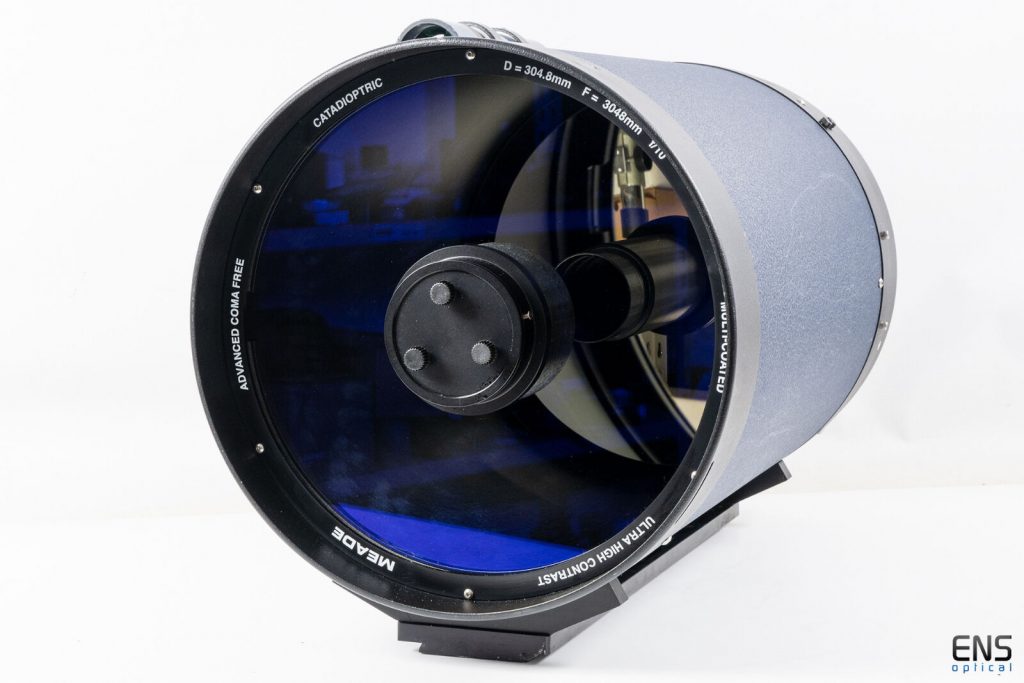
The hyperbolic secondary mirror itself is mounted directly on the rear of the corrector lens, rather than in the traditional RC’s conventional spider vane assembly. This eliminates the image-degrading diffraction spikes of the secondary mirror support structure visible in commercial R-C scope images.
The corrector plate seals the optical tube so preventing ingress of dust onto the primary mirror but, as with all S-C telescopes, will need a longer cool down time than an open tube telescope.
The cool down time can be shortened by using a Lymax ‘CosmicOne’ Ventilator from Rother Valley Optics at £129.
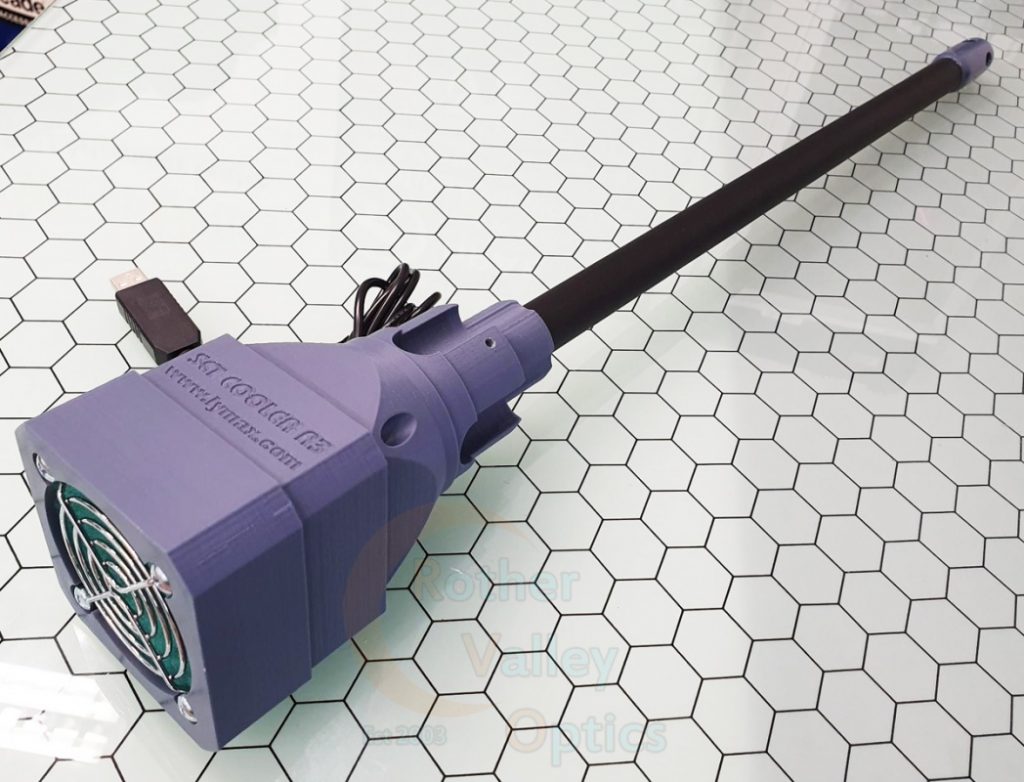
The Meade Optical tubes can, in principle, be bought either as optical tubes from £2,812 to £9,400 or on either Twin Fork Alt/Az or equatorial mounts. The range can be seen on the Meade US website:
https://www.meade.com/advanced-coma-free-telescopes.idx
The optical tubes and mounts are made at their factory near San Diego:
https://www.meadeuk.com/2021-11-01-Meade-Instruments-Tijuana-factory.html
Meade invested 10 million dollars in new optics manufacturing equipment a few years ago which allows Meade to grind and polish aspherical optics, unlike the Celestron Edge HD that only uses spherical optics and as is, a result, a more complex and expensive optical design. The Meade Schmidt- Cassegrain’s also use an oversized primary mirror ( for example,8.25 inch diameter for the 8 inch and 10.375 for the 10 inch ) to collect the light refracted out by the corrector lens as seen in the optical diagram below.
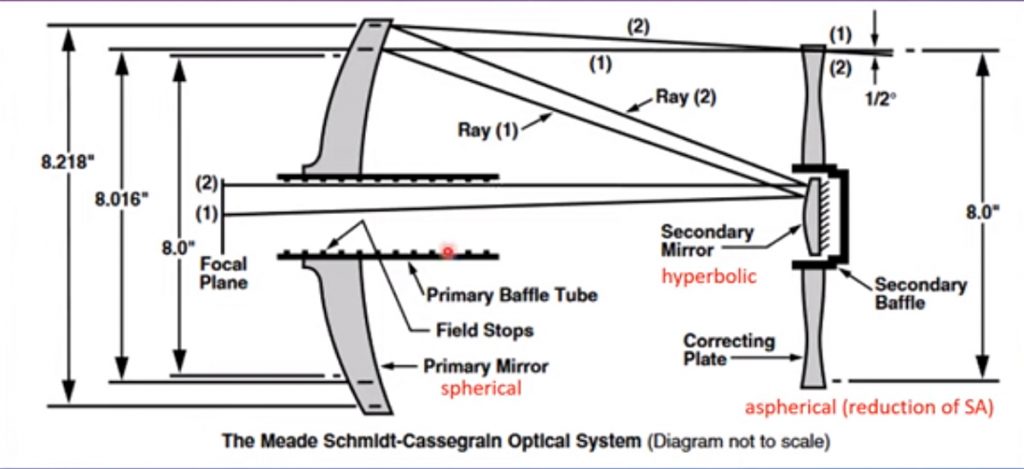
The UK Meade distributors are Opticstar: https://www.meadeuk.com/ who should be contacted as to availability of their combined OTA/Mounts or optical tubes. At the time of writing, only the 10 and16 inch tube assemblies were shown on their website.
They are good optical tube assemblies and give comparable results with the far more expensive Celestron Edge HD. Only 3 optical elements are employed; corrector plate, spherical primary and aspheric Mangin type lens/mirror (secondary) as opposed to 6 in the Celestron Edge HD. There are only 5 optical surfaces in the ACF and 10 in the Edge HD so perhaps a slightly brighter image will result as both use similar anti-reflective coatings. In terms of image quality, the Edge HD will show slightly more detail in the centre, so perhaps better for planetary imaging, but the ACF performs better towards the field edge. Coma, as implied by the name, ACF, is eliminated but the stars, still round, do get slightly larger to wards the field edge – easily fixed in post processing if desired.
Both the ACF and Edge HD are excellent telescopes. I instrumented the COSMOS observatory on St Martin’s, Isles of Scilly some years ago and specified a Meade 12 inch telescope. It has performed very well.
Celestron
Provide 9.25, 11 and 14 inch aperture S-Cs of the original designs. Theoptical tubes cost £1,895, £2,759 and £7,799 respectively. The9,25 and 11 inch OTAs are also available on twin fork Alt/Az mountsat £2,789 and £3,995.
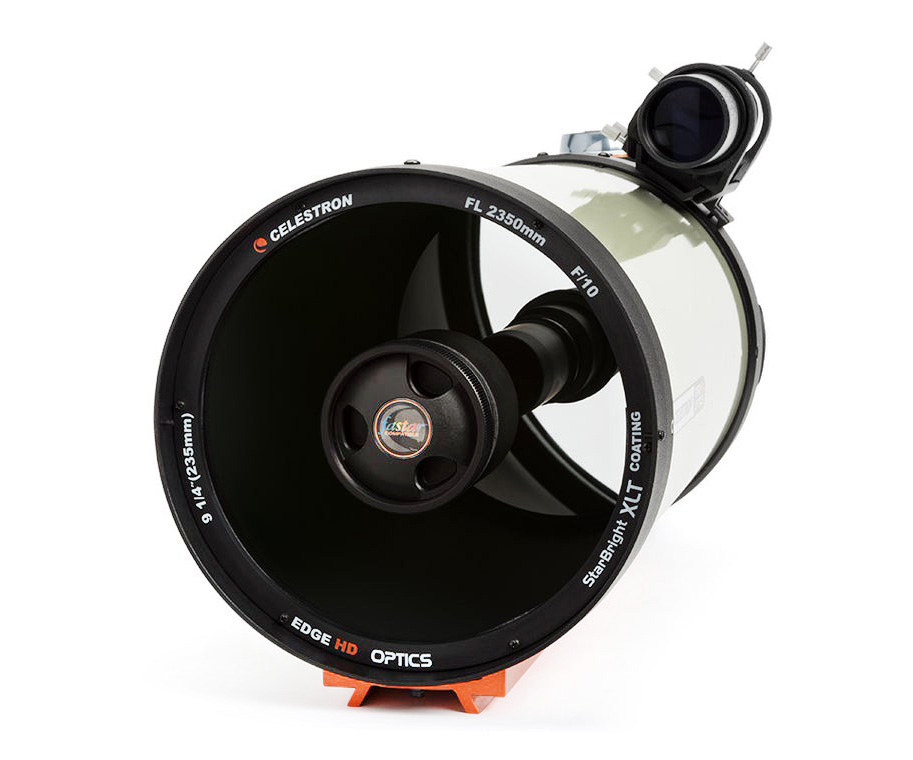
For planetary observing and imaging these are fine as a wide, coma free, field of view is not required. More recently, they have produced their Edge HD versions which include lens elements located in the baffle tube to provide a wide, aberration free, field of view. These would be better for lunar and DSO observing and imaging but do cost considerably more. They do, however, include design improvements in the OTAs as well so are now it is these that are most commonly bought. The OTA costs are £2,994, £4,199 and £9,199 respectively. The specific focal reducers are also considerably more expensive than the simple 2 element design for the original OTAs.
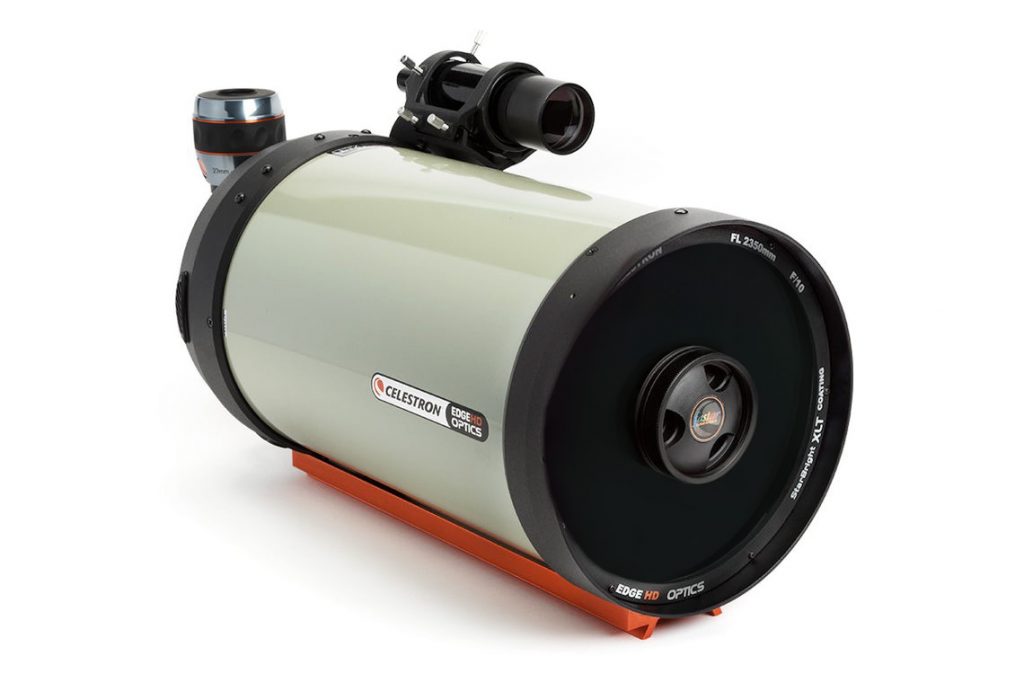
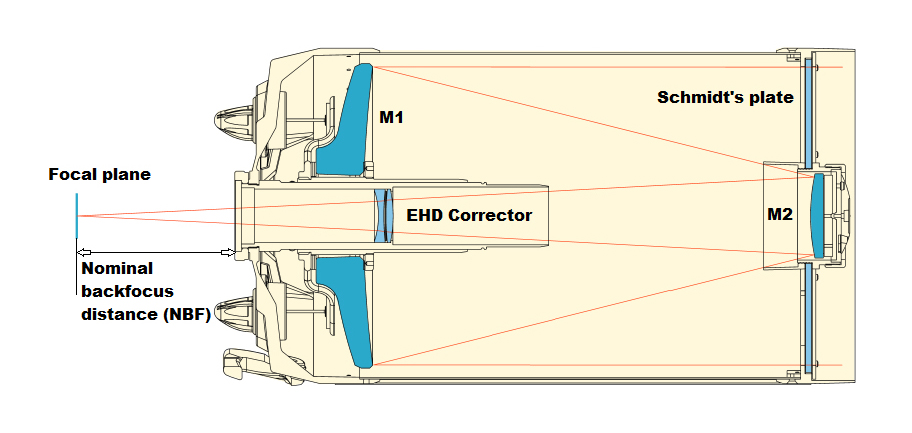
The9.25 inch OTA has a different optical design to the other CelestronS-Cs in that the spherical primary mirror has a longer focal ratiothan the others and the secondary mirror is less curved. This meansthat the OTA is longer than it otherwise would be – not muchshorter that that of the 11 inch OTA. This does , however give arelatively wider coma free field of view than that of the others andis said to be ‘the S-C for those who do not like S-Cs’! I have oneof the original design and it is excellent.
Celestron Rowe-Ackermann Telescopes
They are called RASAs – Rowe-Ackermann Schmidt Astrographs .
These use the prime mirrors at their native focal ratio and employ a 4 element rare-earth glass unit at the focal point to give images free from false colour, coma and field curvature.
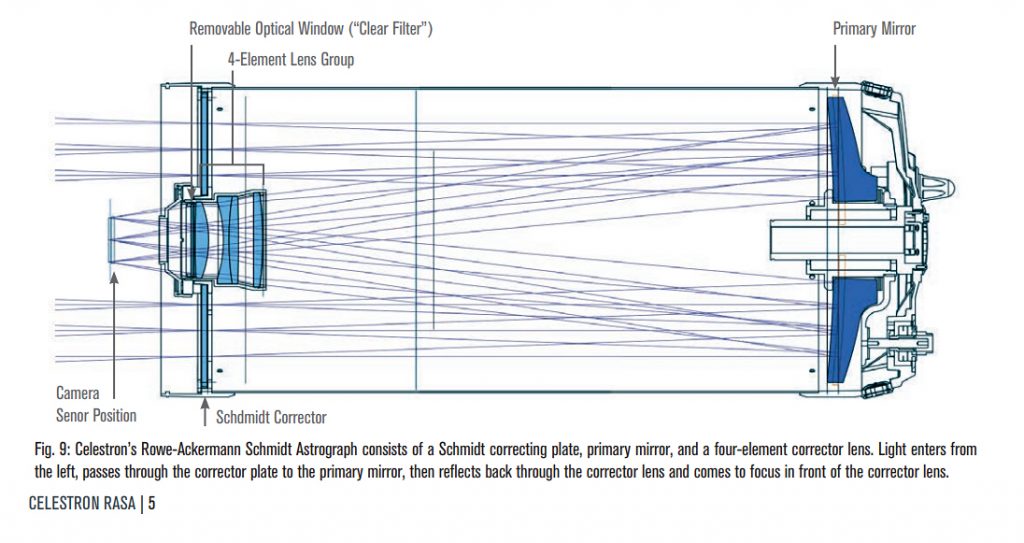
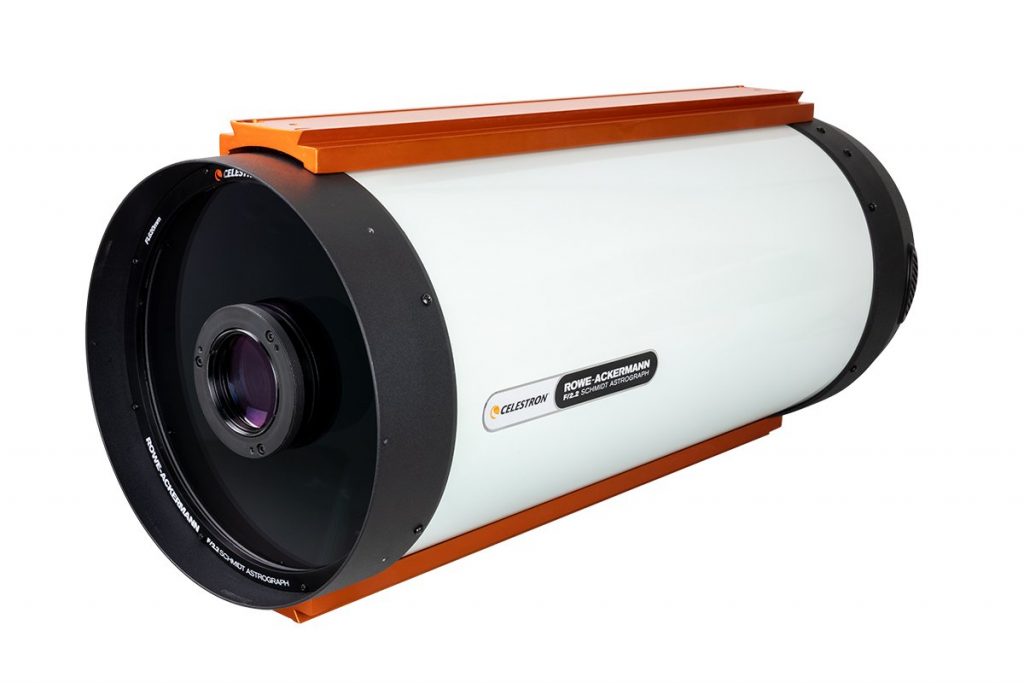
The 11 inch OTA has a focal ratio of 2.22 giving a focal length of 620 mm and costs £4,299. It provides an aberration free, 43 mm, imaging circle so even full frame cameras could be used. The 14 inch OTA has a focal ratio of 2.2 giving a focal length of 790 mm and costs £13,565 and has an imaging circle of 60 mm.
The 11ich RASA is designed to deliver a 4.4 micron RMS spot size across a 4° field of view and has a 2 micron spot sizes 22mm off-axis so a camera whose sensor has very small pixels can realise the full resolution of the telescope.
The latest versions have redesigned focussing systems. At the heart of this USFS system is a precision linear ball bearing. The bearing minimizes focus shift (unwanted lateral movement of the primary mirror during focusing, which causes shifting of the image) and mirror flop (movement of the primary mirror when the telescope is pointing to different positions in the sky). A Feather Touch 10-1 focuser is included as standard. The USFS is compatible with the optional Celestron Focus Motor (#94155-A).
An integrated 12V DC MagLev fan reduces the cool-down time and provides optimal airflow through the dust-filtered optical tube.
The table below gives an idea as to how the low f/ratio reduces the relative time to required to capture deep sky images. Exposures can be ~25 times shorter than the f/10 focal ratio Schmidt-Cassegrains allowing galaxies and nebulae to be captured in just 30 seconds!
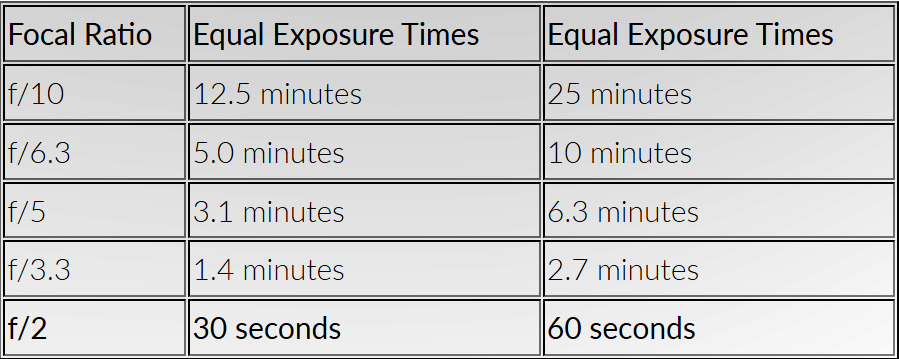
An APS-C camera on the 11 inch RASA will show almost no vignetting and give a 2 x 1.4 degree field of view. Even full frame cameras can be used as the telescope provides 78% illumination in the corners which is easily compensated for by the use of flat fields. They would provide a field of view of 3.3×2.2 degrees. The table below gives the field of view for a number of camera sensor sizes.
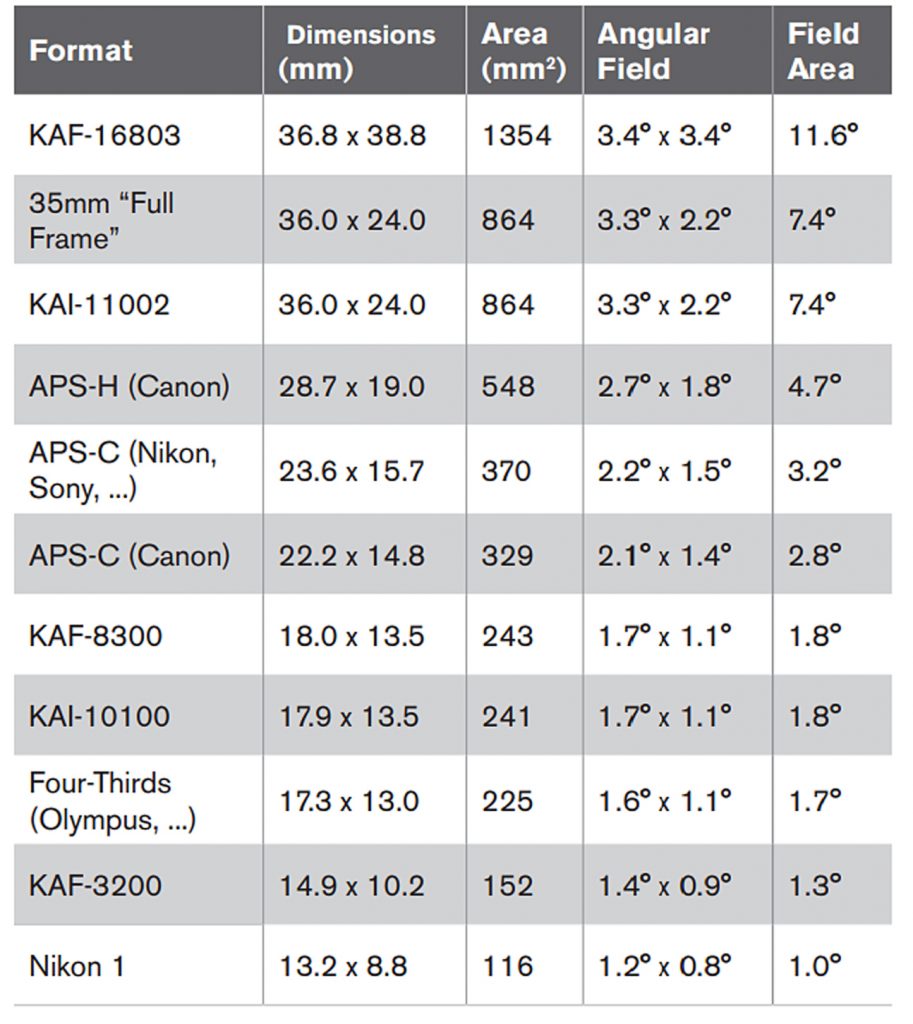
Because the camera is mounted on the front of the telescope, the camera should be compact. The correcting lens assembly of the RASA acts as an obscuration 114mm in diameter, so cameras that fit within a 114mm circle will block no additional light. However, even bulky DSLR cameras that protrude outside the114mm circle add little additional obscuration. CCD or CMOS sensors mounted in slender cylindrical camera bodies (up to about 125 m diameter) are best, and add little or no additional obscuration.
Though full frame DSLR cameras can be used, the fact that the sensor is well back behind the mirror box means that some vignetting will occur. A mirrorless camera has no mirror box and not exhibit significant vignetting.
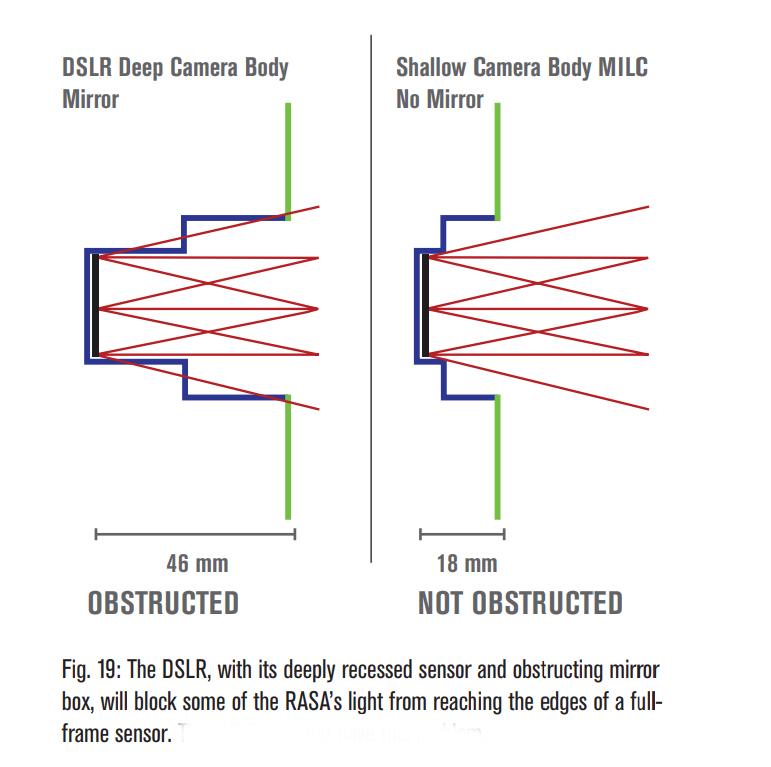
Without a camera in place, the 11-inch RASA is 84cm long from front cell to the rear of the Feather Touch focuser and weighs a hefty 43lbs(19.5kg). It is therefore not an optical tube that you would wish tomount and dismount too often and is best suited to permanent observatory setups.
Starizona Celestron Hyperstar Conversions
The Starizona Hyperstar conversions replace the secondary mirror assembly with a unit containing optical elements to give produce a telescope with a focal ratio of f/1.9 for the 11 inch (that of the primary mirror), f/2 for the 14 inch model and f/2.5 for the the 9.25 OTA. The latest version 4 units provide an image circle of 28mm diagonal for the 9.25 and greater for 11 (35mm) and 14 inch (43mm) models theso can cover up to an APS-C sized sensor in the 9.25 and 11 inchmodels but even a full frame sensor for the 14 inch model but withsome correctable vignetting.
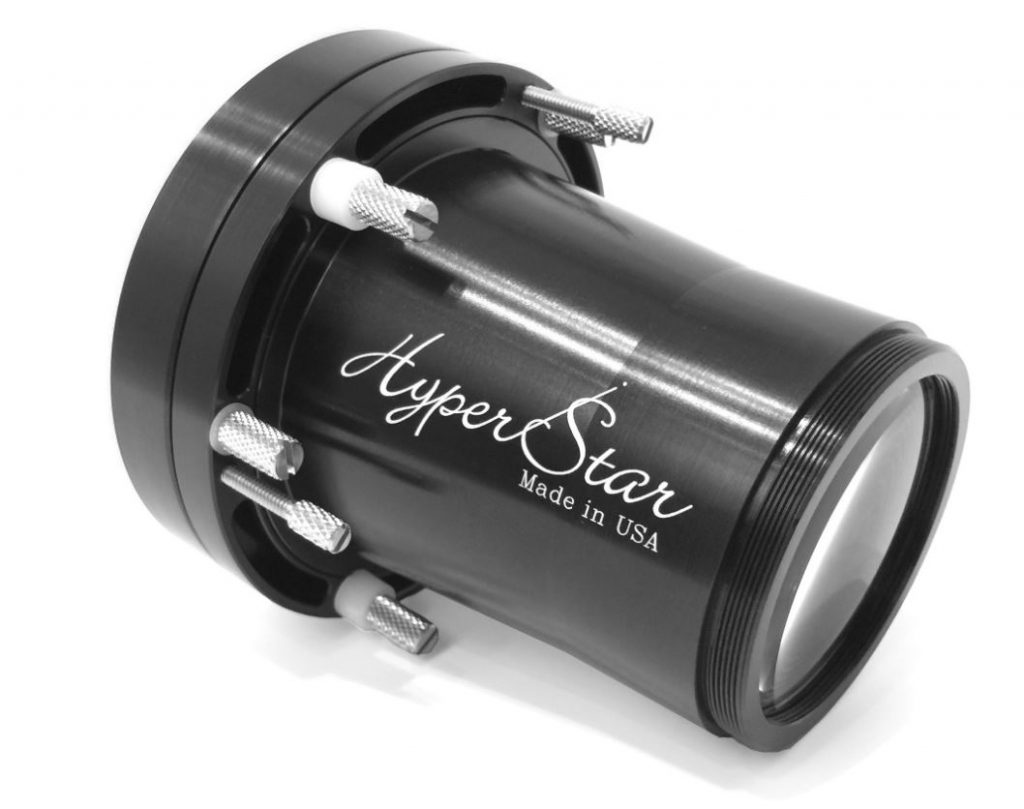
The Hyperstar conversion kits for recent 9 .25, 11 and 14 inch Celestron OTAs cost £1,199, £1,299 and £1,399 respectively. Slightly different versions are available at the same cost for the Edge H Dversions. [Note: The Edge HD OTAs will give identical results to the standard versions.] For £359, conversion kits are available for earlier models to allow the Hyperstar to be mounted in place of the secondary mirror. Switching between the normal and Hyperstar modesis quite quick but it is said that collimation is a bit tricky.
The very low f ratio allows very short exposures to image deep sky objects and makes the use of an At/Az mount very feasible. The fields of view will be much greater as the effective focal lengths are that of the primary mirror; these are 540 mm for the 9.25, 540 mm forthe 11 inch and 715 mm for the 11 inch. The field of view using anAPS-C sensor on the 9.25 OTA is ~3×2 degrees and somewhat greater forthe 11 and 14 inch OTAs. Thus all three can easily encompass M45,the Pleiades Cluster.
Ritchey-Chrétien Telescopes
The Ritchey-Chrétien optical design is a form of Cassegrain telescope designed to eliminate coma (which is suffered by standard Schmidt-Cassegrains) and provide a relatively large field of view. Toachieve this, in a RC telescope the primary and secondary mirrors are hyperbolic in shape. Since there are only two mirrors, they have no spectral dispersion or chromatic aberration and, as there are only two optical surfaces (Schmidt-Cassegrains have 4), there should be less degradation of the wavefront passing through the telescope.Using no lenses (which also scatter some light), they can cover awider part of the visible and Infrared spectrum. Ritchey-Chrétien telescopes also give a flatter field than a SC as the secondarymirror has less curvature and thus a lower amplification factor –typically 2.7x rather than 5x. Their focal ratio is typically f/8rather than f/10 for a Schmidt-Cassegrain.
The sedo have fixed (but can be collimated) primary mirrors so there can be no focus shift or mirror flop and they do have focusers at the rear of the telescope.
However, to give a large un-vignetted field of view, their secondary mirror has a large, ~47%, diameter obstruction. This will reduce the ‘micro-contrast’ of the image by taking light away from the central Airy Disk into the surrounding rings. Thus these telescopes are, perhaps, better optimised for DSO imaging rather than for visual use
Sold under a wide variety of brand names, that are all made by GSO – Guan Sheng Optical in Taiwan. Their smallest in the large compact telescope range has an aperture of 10 inches and can be bought in a closed tube for ~£2,499 or, with an open tube for £2,999. I would firmly recommend the open, truss tube, design as the closed tube version (as with their smaller telescopes) have a design flaw in that the focus assembly is attached to the primary mirror which makes their collimation a problem – I know, I have an 8 inch R-C. The truss tube versions are beautiful looking telescopes and a colleague is very pleased with his 10 inch aperture telescope.
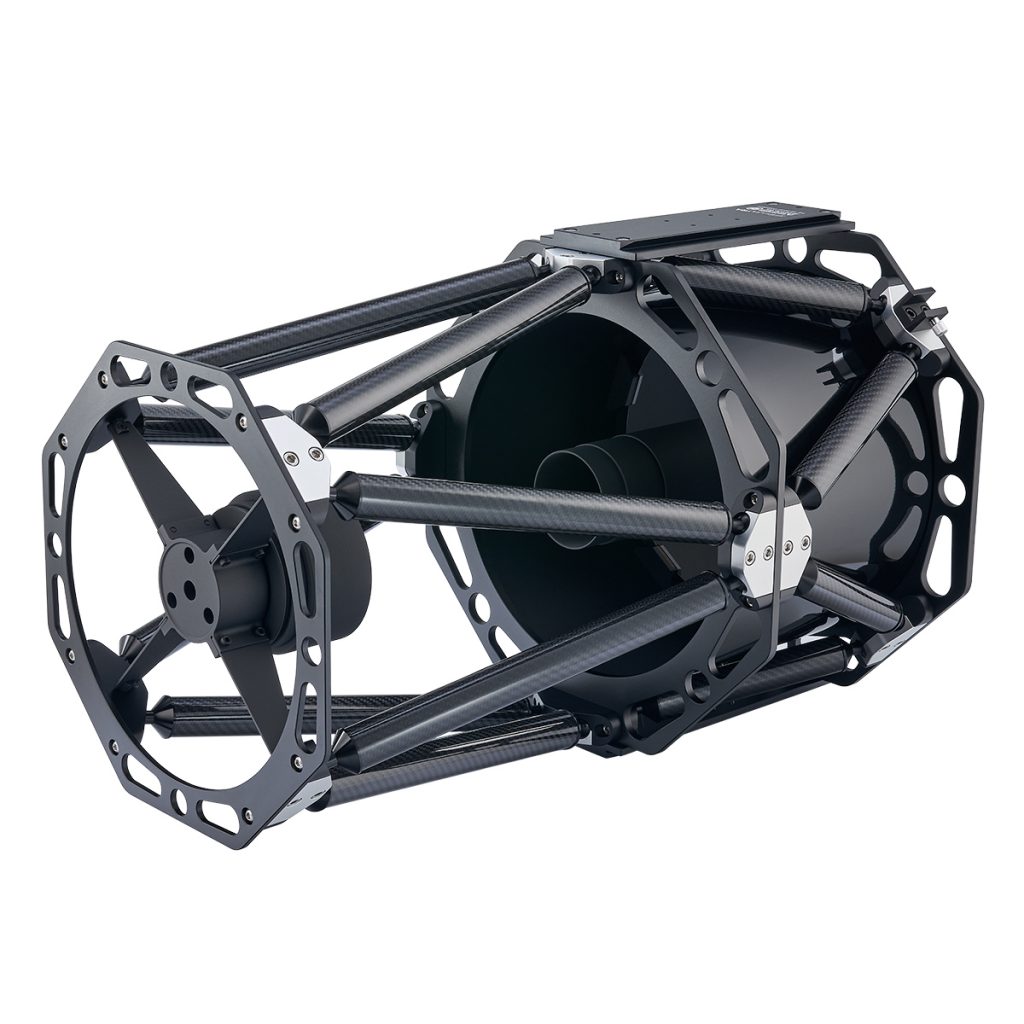
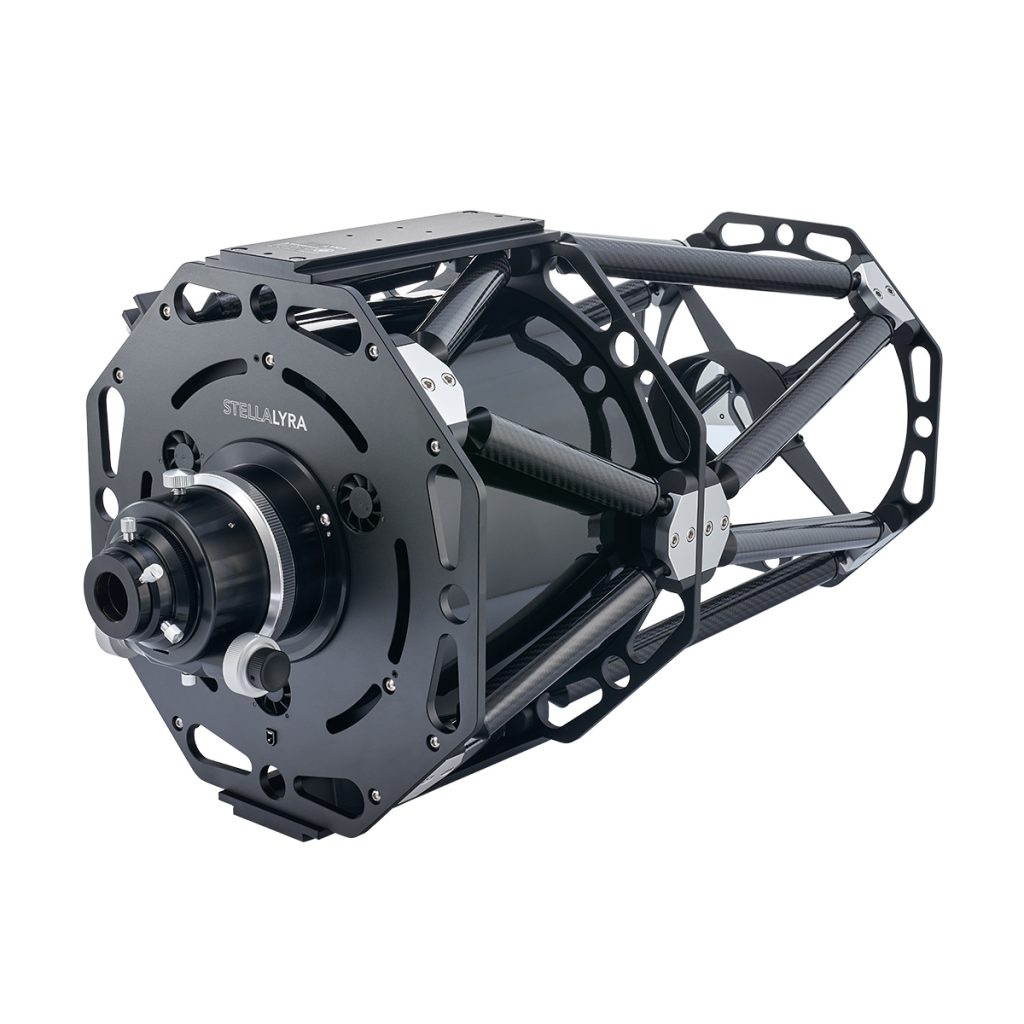
It will need, however, a suitable mount to support it. They also produce OTAs with12 inch (£4,050), 14 inch (£6,395) and 16 inch (£7,895) apertures.
Klevtsov–Cassegrain and Sub-Aperture Maksutovs
The Maksutov meniscus corrector plate is quite heavy and not really practical above ~200 mm aperture so one approach, used by Orion Optics around 2005, was to locate a small corrector element in front of the secondary mirror – a so called a sub-aperture Maksutov. They produced 250 and 300 mm aperture tube assemblies. These have not been made for many years now but second hand OTAs but cansometimes be found. (See Ukastrobuysell). The Russian optical company TAL produce a 250 mm Klevtsov–Cassegrainbut, due to the current conflict, new ones at around £2,000 are notavailable at present.
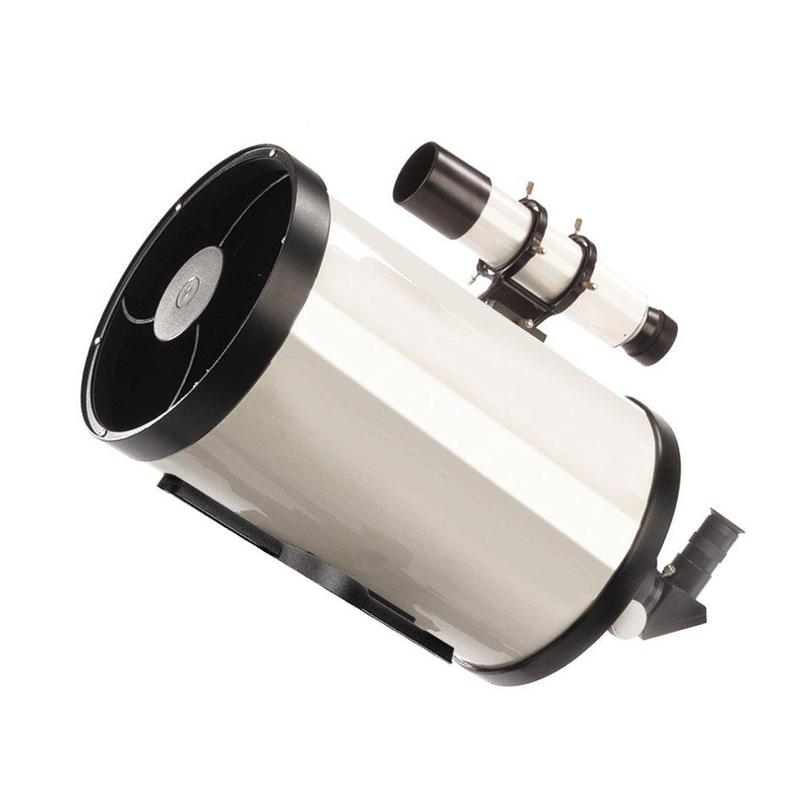
Both telescopes have very similar optical designs and, surprisingly, the cross section diagram of the Orion Optics OMC250 does include the words ‘Klevtsov–Cassegrain’. But looking at the two diagrams one can see that the corrector elements are different. The OMC250/300 have a thick meniscus corrector element placed in front of thesecondary mirror. In contrast, in the Klevtsov design the meniscus corrector is in front of a ‘Mangin’ lens element where the rear ofthe lens is silvered to act as the secondary mirror. [The light passes through these corrector elements twice rather than once for astandard Maksutov so they must be of high optical quality.]
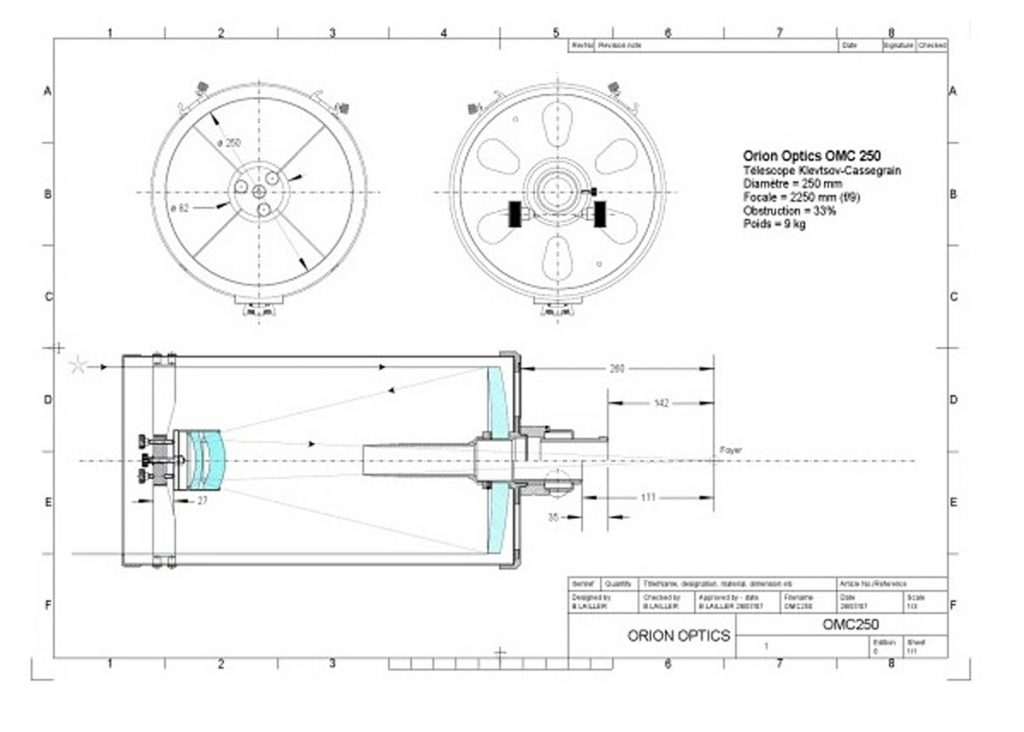
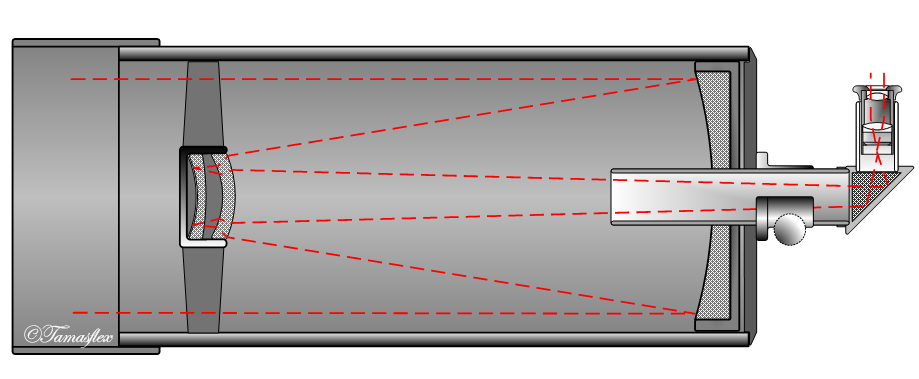
The secondary mirror/corrector is supported by a spider. That in the OMC250/300 has 4 straight vanes so that diffraction spikes will be seen on bright stars. That in the TAL is supported by three curved vanesas seen in the image and does not produce diffraction spikes.
In contrast to the S-Cs the the OTAs are open so cool down times will be shorter and with standard focusers at the rear of the tube assemblies that will be no focus shifts or mirror flops – good.